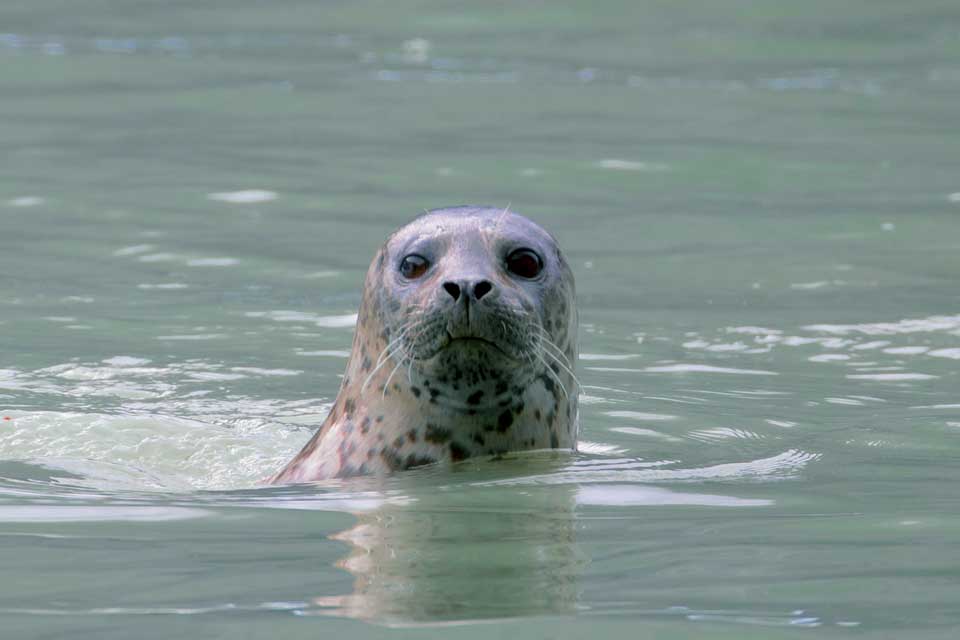Harbor seals are Phocids—they are part of the true seal family. They have no visible ear flaps (called pinnae), only a small hole is visible. They are one of the most common marine mammals in the US.
Harbor seals are covered in short bristle-like fur. The color of their fur varies, but there are two basic patterns: light tan or silver with dark speckling or spots, or dark background with light rings.
In water their hindflippers spread side to side to move them along and foreflippers are used for steering. They are graceful swimmers but are not agile on land and typically “phocidulate,” which means they move on land by undulating or heaving the body in a caterpillar-like manner using foreflippers to pull themselves along. They have short necks and flippers and cannot pull their hind flippers under their body while on land.
Males are only slightly larger than females.
There are five stocks of harbor seal:
Alaska
California
Oregon-Washington coastal
Washington inland
Western North Atlantic

Harbor seal pups can swim at birth. By the time they are 2 to 3 days old they can dive for up two minutes.
During winter, the blubber layer makes up 27-30% of their total body mass.
North America, Europe, Asia
In North America:
East Coast (Canadian Arctic as far south as the Carolinas)
West Coast (Bering Sea to California)
Rocks and beaches along the coast, floating ice in glacial fjords. Nearshore coastal waters. Seasonal use of glacial fjords to give birth on icebergs.
Fish, shellfish and crustaceans
Transient orcas, sharks, sea lions, humans, land predators (wolves and bears), and eagles may take newborn pups
Harbor seals are usually solitary while foraging in water. They haul out (rest) in groups on rocks, beaches and ice to avoid predators, regulate their body temperature, molt, socialize, give birth and raise their pups. If they feel threatened while hauled out, they are quick to retreat to the water. They are otherwise very inquisitive.
In winter, seals spend 80% of their time in the water. Adults can sleep underwater and come up for air once every 30 minutes. They hunt in both shallow and deep water depending on the availability of prey. They are known to dive up to 1,640 feet deep, but most dives are less than 65 feet deep and 4 minutes long.
Harbor seals are nonmigratory and typically stay within 30 miles of their home base, though they have been documented traveling as far as 250 miles away.
All seals can communicate vocally through hisses, grunts and other sounds, but harbor seals are the least vocal of the pinnipeds.
Harbor seals generally give birth in spring and summer—usually in May in Southeast Alaska. In the south they are born earlier than in the north.
Gestation is about 10 months. Pups are fed milk that is 50% fat so they gain weight quickly and are weaned and separated from their mother after only one month. Harbor seals raise their pups in nurseries, which are groups of mothers and young. This behavior helps protect seals from predators.
Threats to harbor seals include entanglement, harassment, habitat degradation, contaminants, oil spills, vessel strikes, disturbance, and disease. Until 1960, bounty hunters culled harbor seals in Washington and Oregon because they were competing with commercial fishermen. Harbor seals are protected under the Marine Mammal Protection Act. Hunting is restricted to Alaska Natives for subsistence.
Harbor seal stocks along the West Coast of the US are stable and some are increasing. The population in New England is also increasing. But in Alaska harbor seals are considered a Species of Special Concern. Seals in Glacier Bay have been known to be declining since the early 1990s despite efforts to control vessel traffic, commercial fishing and subsistence harvest. Overall, seals in the Arctic regions have declined 80% over the last 30 years. The cause is unknown but may be related to ocean warming.